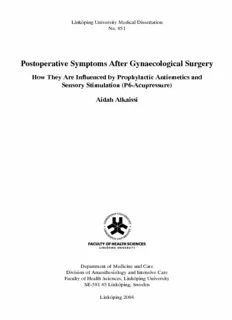
Postoperative Symptoms After Gynaecological Surgery How They Are Influenced by Prophylactic ... PDF
Preview Postoperative Symptoms After Gynaecological Surgery How They Are Influenced by Prophylactic ...
Linköping University Medical Dissertation No. 851 Postoperative Symptoms After Gynaecological Surgery How They Are Influenced by Prophylactic Antiemetics and Sensory Stimulation (P6-Acupressure) Aidah Alkaissi Department of Medicine and Care Division of Anaesthesiology and Intensive Care Faculty of Health Sciences, Linköping University SE-581 85 Linköping, Sweden Linköping 2004 2 Postoperative Symptoms After Gynaecological Surgery How They Are Influenced by Prophylactic Antiemetics and Sensory Stimulation (P6-Acupressure) Copyright© Aidah Alkaissi 2004 Supervisor Sigridur Kalman Cover design Yazan Alkaissi ISBN 91-7373-822-0 ISSN 0345-0082 Linköping University Medical Dissertation No 851 Printed in Linköping, Sweden By Unitryck Linköping 2004 3 Destiny is not a matter of chance, it is a matter of choice; it is not a thing to be waited for, it is a thing to be achieved. William Jennings Bryan 4 To Hazim, Yazan, Wasan and Hammoudi To my Parents, brothers and sisters With love 5 CONTENTS ABSTRACT.............................................................................................................................7 ABBREVIATIONS..................................................................................................................8 DEFINITION OF TERMS.......................................................................................................9 ORGINAL PAPERS..............................................................................................................11 INTRODUCTION..................................................................................................................12 BACKGROUND....................................................................................................................14 Physiology of postoperative nausea and vomiting...........................................................................................14 Risk factors for PONV in adults.......................................................................................................................15 Scores for the assessment of clinical risk for PONV........................................................................................17 Management of PONV.....................................................................................................................................18 Dopamine (D) receptor antagonist.............................................................................................................19 2 5-HT receptor antagonists..........................................................................................................................20 3 Oxygen, hydration, and oral intake..............................................................................................................20 Slow deep breathing....................................................................................................................................20 Sensory stimulation.....................................................................................................................................21 Acupuncture and acupressure.................................................................................................................21 Control of symptoms that influence the incidence of PONV......................................................................21 Pain control.............................................................................................................................................21 Avoid hypotension and variation in blood pressure................................................................................22 AIM........................................................................................................................................23 PATIENTS AND METHODS...............................................................................................24 Procedures..............................................................................................................................................30 In Studies I and II...............................................................................................................................30 In Study III.........................................................................................................................................30 In Study IV.........................................................................................................................................30 Predicting risk for PONV.......................................................................................................................31 Assessment of postoperative symptoms using a questionnaire...............................................................31 Explanation of some statistical methods.................................................................................................33 Assessment of patient satisfaction..........................................................................................................33 Ethical considerations.............................................................................................................................33 RESULTS...............................................................................................................................34 Symptoms.........................................................................................................................................................34 After gynaecological surgery under general anaesthesia.............................................................................34 After prophylactic treatment with granisetron or droperidol.......................................................................38 After prophylactic treatment with P6- and placebo acupressure, granisetron and droperidol.....................41 P6-acupressure and placebo acupressure..........................................................................................................42 Subgroup analysis after vaginal and laparoscopic surgery..........................................................................43 Requirement of rescue antiemetics...................................................................................................................44 Patient satisfaction............................................................................................................................................45 Adverse events.................................................................................................................................................45 Acupressure band........................................................................................................................................45 Granisetron and droperidol..........................................................................................................................46 The Questionnaire............................................................................................................................................48 Correlation between the Apfel risk score for POV and the observed PONV and POV...................................48 P6- and placebo acupressure and experimental motion sickness.....................................................................48 DISCUSSION........................................................................................................................50 Postoperative symptoms...................................................................................................................................50 Methods............................................................................................................................................................56 Questionnaire...............................................................................................................................................56 End point measured.....................................................................................................................................57 Pharmacological treatment of PONV..........................................................................................................59 P6-acupressure.............................................................................................................................................59 The cost-effectiveness of antiemetics..........................................................................................................60 Motion sickness...........................................................................................................................................61 Clinical implications........................................................................................................................................61 CONCLUSION......................................................................................................................63 ACKNOWLEDGEMENTS...................................................................................................64 REFERENCES.......................................................................................................................67 APPENDIX 1.........................................................................................................................78 The Swedish Postoperative symptoms Questionnaire......................................................................................78 PAPER I PAPER II PAPER III PAPER IV Abstract 7 ABSTRACT Symptoms after surgery and anaesthesia influence the patient´s ability to resume daily activities. If postoperative symptoms are controlled rehabilitation may be accelerated. The aims of this dissertation were to identify disturbing symptoms reported by patients after gynaecological surgery, to investigate what effect prohylactic treatment with antiemetics has on these symptoms and whether or not sensory simulation of the P6-acupressure has an effect on postoperative nausea and vomiting (PONV) and motion sickness. Methods: Total 1138 women participated in three clinical trials (Studies I, II, III) and one experimental study (Study IV). A questionnaire investigating postoperative symptoms was constructed and validated. The questionnaire was used in a prospective, consecutive, double- blind, randomised, multicentre, and controlled study to identify incidence, and intensity of postoperative symptoms and the effect of common antiemetics (droperidol and granisetron) (Study III). The patients were followed for 24 h. In two studies (I, II) P6-acupressure was compared (prospective, double-blind, ransomised, controlled) with placebo acupressure and a reference group where the effect on PONV was followed over 24 h. The effect of P6- acupressure and placebo acupressure on motion sickness induced by a nauseogenic motion challenge was studied (Study III). Results: A high incidence and severity of postoperative symptoms were found after gynaecological surgery in a group with a high risk (>30%) for PONV. Sixty-four per cent (107/165) of the patients experienced disturbing symptoms after surgery and 46 % (76/165) scored their symptoms as moderate to very severe. Fourty-eight per cent (79/165) had two or more symptoms. A higher incidence of symptoms were reported in the groups with prophylactic treatment, granisetron 74% (123/165) and droperidol 80% (133/165) compared to the control group 41% (69/165) (P <0.05). The relative risk reduction for PONV with granisetron or droperidol prophylaxis is 27% respective 22%. The relative risk increase for headache is 63% after granisetron, and 44% for difficulty with accommodation after droperidol. Less PONV was seen after P6-acupressure, 33% (44/135) compared to reference group 46% (63/136) (p = 0.019), number needed to treat (NNT) was 7 [95% confidence interval (CI) 4- 6]. When comparing laparoscopic and vaginal surgery (subgroup analysis) the main effect was in the vaginal group (day-case surgery), 36% (27/75) in the reference group to 27% (23/86) in the placebo group and to 20% (17/84) in the P6-acupressure group, (P = 0.017), NNT for the vaginal group was 6 [95% CI 3-18]. P6-acupressure increased time to nausea after a laboratory motion challenge and reduced the total number of symptoms reported (p <0.009). Conclusions: There is no clinical efficacy in the form of reduced postoperative symptoms after prophylactic antiemetics (droperidol and granisetron) in females with a high risk (>30%) for PONV undergoing gynaecological surgery. P6-acupressure reduces the incidence of PONV after gynaecological surgery in females with a high (>30%) risk for PONV. The effect seems to be most prominent after vaginal surgery. P6-acupressure increased tolerance to experimental nausogenic stimuli and reduced the total number of symptoms reported in females with a history of motion sickness. Keywords: Acupuncture, P6-acupressure, antiemetics, PONV, gynaecological surgery, motion sickness, eccentric rotation, coriolis effect, antiemetic prophylaxis, granisetron, droperidol. 8 Alkaissi Aidah ABBREVIATIONS ANS Autonomic Nervous System AP Area Postrema CCKA Cholecystokinin A CTZ Chemoreceptor Trigger Zone D Dopamine receptor-subtype-2 2 5-HT 5-HydroxyTryptamine receptor-subtype-3 3 5-HT 5-HydroxyTryptamine (serotonin) GABA Gamma-Amino-Butyric Acid MANE Morrow Assessment of Nausea and Emesis NK1 Neurokinin 1 NTS Nucleus of the Solitary Tract PONV Postoperative Nausea and Vomiting POV Postoperative Vomiting TAES Transcutaneous Acupoint Electrical Stimulation
Description: